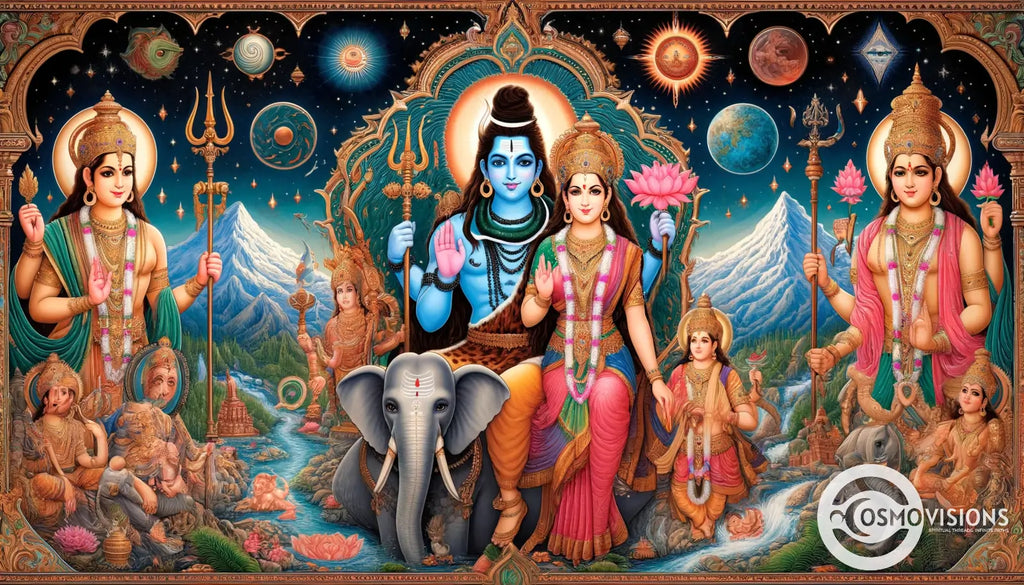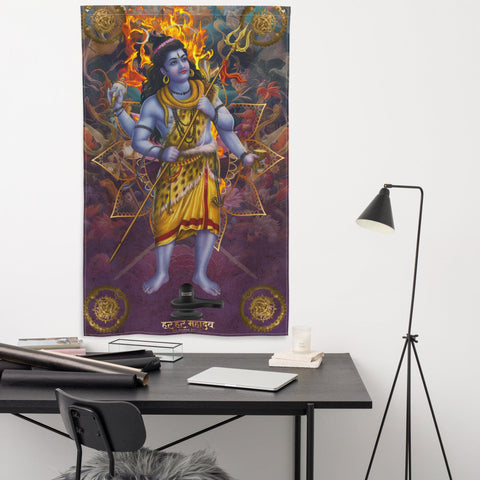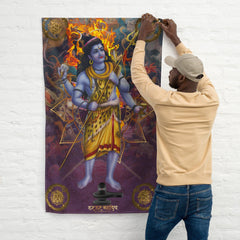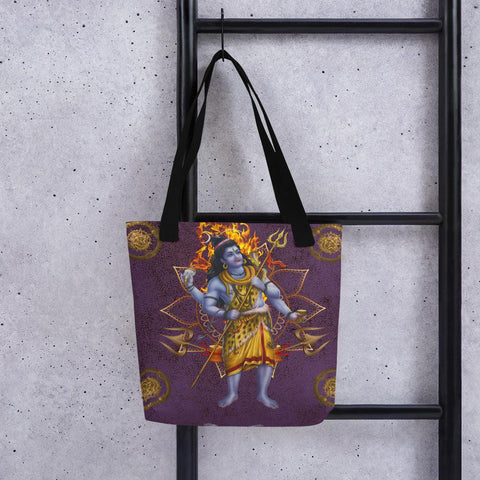Exploring the Family of Lord Shiva: The Divine Connections
Posted by Massimiliano Geraci

Exploring Hindu mythology brings us closer to understanding the complex tapestry that forms the basis of the Hindu religion, one of the world’s oldest religions. Many seekers find themselves drawn to the enigmatic figure of Lord Shiva, whose tales are rich with wisdom and insight.
A common challenge for enthusiasts is piecing together Shiva’s familial connections - a divine puzzle steeped in deep philosophical and theological significance.
An intriguing aspect about Shiva is his role within his family, where he embodies the duality of destruction and regeneration, acting both as a destroyer within the Trimurti alongside Brahma and Vishnu, and as a loving husband to Goddess Parvati and father to Lord Ganesha and Lord Kartikeya.
This article invites readers on an enlightening journey through legend and lore to reveal how each member contributes uniquely to Hindu spirituality. Discover temples dedicated to this revered deity, explore legendary stories that have captivated generations, and learn why Shiva holds an esteemed position as both a supreme lord and a devoted family man.
Join this spiritual exploration with us.
Who are the members of the family of Lord Shiva?
Lord Shiva, revered in Hinduism and a principal deity in the pantheon of Indian spirituality, forms a divine family that embodies powerful symbols and teachings relevant to life and the universe.
At his side stands Goddess Parvati, also known as Devi Shakti, representing strength, fertility, and marital felicity. Their bond is not just one of companionship but also signifies the union of consciousness and energy.
Their progeny include Lord Ganesha, widely worshipped as the remover of obstacles and patron of arts and sciences; Lord Kartikeya, a warrior god epitomizing bravery; goddess Ashoka Sundari who symbolizes hope; Manasa Devi who presides over snakes and poisons offering protection against snake bites; Ayyappan (also considered their son), revered for his ascetic nature. According to the Padma Purana, Shiva and Parvati have three children: Lord Kartikeya, Lord Ganesha, and Ashoka Sundari.
Nandi, the divine bull vehicle of Shiva, holds an integral place in this celestial family setup by serving both as Vahana (vehicle) to Shiva and gate guardian to Kailash Parvat where they reside.
This distinctive composition underlines unity amidst diversity showcasing aspects like knowledge (Ganapati), valor (Kartikeya), serenity (Ashoka Sundari), health (Manasa), discipline (Ayyappan), loyalty (Nandi) thus teaching humanity various facets of righteous living through devotion.
Exploring the Relationship between Lord Shiva and Goddess Parvati
Shiva and Parvati's union symbolizes a profound confluence of the divine masculine and feminine forces within the cosmos, embodying principles that transcend mere mythology to touch upon universal themes of balance, duality, and harmony.
Their relationship is not just central to Shaivism but resonates across various Hindu traditions, including Shaktism where Parvati is venerated as Mahadevi, the great goddess. As Lord Shiva represents consciousness and Parvati signifies power (Shakti), their narrative highlights how life emerges from the interplay of these primal energies.
This sacred partnership illustrates the concept of Ardhanarishvara—where Shiva and Parvati are depicted as half-man and half-woman—which further underscores their inseparability in creating and maintaining the universe.
The stories surrounding Shiva and Parvati serve as metaphors for devotion, strength, purity, and perseverance. Goddess Parvati underwent rigorous penance to win Lord Shiva's heart after Sati—Parvati's previous incarnation—self-immolated in her father Daksha’s sacrificial fire due to disrespect towards Shiva.
This tale underlines loyalty's might against all odds—a theme popularly celebrated during regional festivals dedicated to them such as Navaratri. Furthermore, it speaks volumes about cosmic law: even deities undergo trials for love's triumph.
In illustrating how Parvati became part of Mount Kailash alongside Shiva while nurturing their two sons Ganesha—the remover of obstacles—and Kartikeya—the warrior god—it emphasizes family values embedded deep meditation and within celestial narratives beyond earthly perceptions.

Meet the Two Sons: Lord Ganesha and Lord Kartikeya
Transitioning from the celestial union of Lord Shiva and Goddess Parvati, we move to their progeny, who hold significant roles in Hindu mythology. Lord Ganesha, widely revered as the remover of obstacles and god of beginnings, is universally recognized by his elephant head.
Legend narrates that he received this distinctive feature from Shiva himself, under dramatic circumstances involving protection and maternal honor. Ganesha's iconography is rich with symbols: his large ears listen to the prayers of devotees; a broken tusk represents sacrifice; and his mount, a mouse, signifies control over ego.
In rituals across Hinduism, worshipers often invoke him first among all deities before commencing any religious or spiritual activity.
Lord Kartikeya, also known as Murugan or Skanda in various regions, stands out as the god of war and victory. Stories depict him leading divine armies into battle against demons threatening cosmic harmony.
Born for the sole purpose of destroying Tarakasura—a demon only defeatable by Shiva’s offspring—Kartikeya epitomizes valor and purity. His portrayal riding a peacock that symbolizes destruction of serpent spirits conveys his dominion over harmful forces threatening devotional pursuits and human well-being.
In devotion to Ganesha and Kartikeya lays the essence of overcoming adversity through wisdom and courage.
What Role Does Nandi Play in the Family?
Nandi, the sacred bull of Hinduism, holds a pivotal role in the family of Shiva. Serving as the gatekeeper and vehicle for God Shiva, Nandi embodies loyalty and unwavering devotion.
Positioned at the entrance of many Shiva temples, he represents strength and virility. As an integral part of religious texts like the Vedas and Puranas, Nandi's presence signifies protection and serves as a symbol of good fortune for devotees visiting these sacred sites.
In addition to his guardianship, Nandi shares a close bond with all members of Lord Shiva's family, illustrating respect and reverence within divine relationships. His stories are prevalent in Hindu deities' narratives where his actions reflect the virtues valued by followers: faithfulness, service to others, and humility.
Through rituals involving Nandi across various festivals dedicated to Shua include prayers that seek blessings for prosperity from this mighty creature who connects humanity with divinity in profound ways.
How is the Lord Shiva Family depicted in Shiva Iconography?
In Shiva iconography, the family of Shiva emerges through a rich tapestry of images and statues that symbolize divine connections and eternal principles. The depiction of Shiva alongside Goddess Parvati, their sons Lord Ganesha and Lord Kartikeya, convey themes of unity, knowledge, power, and protection.
Artisans craft these figures with intricate details to represent Shiva’s roles as a father, protector, destroyer of evil, and god of yogis. Each member holds unique attributes; Ganesha with his elephant head symbolizes wisdom and removal of obstacles; Kartikeya riding a peacock represents bravery; Parvati embodies love and fertility. Shiva's blue neck, a distinctive feature, symbolizes the poison he consumed to save the world.
Statues often show Nandi sitting loyally by Shiva’s side or near the entrance guarding temples - highlighting the bond between deity and devotee. Iconic symbols associated with this divine family also include the crescent moon adorning Shiva’s hairpile indicating control over time cycles; the serpent Vasuki around his neck denoting Kundalini energy.
Furthermore, specific poses like Tandava capture dynamism embodying creation-destruction cycles while gestures such as Dakshinamurthy reflect teaching aspects linking him to knowledge seekers across ages.
Lingams installed in Hindu temples echo cosmic energies personified by Shiva manifesting primal simplicity yet profound essence capturing attention from followers around Prajapati’s visual narratives enrich Durga Puja rituals blending mythologies into communal worship marking seasonal changes reflecting deep spiritual insights within pictorial forms enchantingly bridging celestial lore with earthly existence.

Common Images and Photos of the Family of Lord Shiva
Iconography plays a crucial role in Hinduism, encapsulating the essence of divinity and spiritual narratives. Images and photos of Shiva's family often show him with his consort, Goddess Parvati, along with their three children namely, Lord Ganesha and Lord Kartikeya.
These depictions are rich in symbols; for instance, Shiva is usually shown with a serpent around his neck, representing power and eternity. Another common symbol is Nandi, sitting loyal by his side or in front of Shivalingas at temples.
These visuals serve not just as religious iconography but also as gateways to understanding the deeper aspects of life such as duality (Shiva-Parvati), wisdom (Ganesha), and valor (Kartikeya).
Photographs capture the celestial family in moments that highlight their divine attributes: Shiva’s third eye signifies insight beyond ordinary perception while Goddess Parvati represents fertility, love, beauty, marriage, children, and strength.
The images where they appear together symbolize perfect marital harmony and balance between male-female energies within the universe. Visuals from festivals like Diwali and regional celebrations further illustrate how these deities play an integral role in Hindu worship practices across different cultures.
Through sacred visuals lies a path to divine comprehension.
Symbolic Meanings Behind Lord Shiva's Iconography
Lord Shiva's iconography is a rich tapestry of symbols, each narrating stories of cosmic principles and spiritual truths. His depiction with a serpent coiled around his neck symbolizes the power over death and the ego, illustrating Lord Shiva's control over the fearsome facets of existence.
The Ganga flowing from his matted hair tells tales of his role in saving the earth by gently releasing the mighty river onto its surface, showcasing him as a protector deity who harnesses destructive forces for benevolent purposes.
His third eye represents wisdom and insight beyond ordinary perception, signifying the destruction of ignorance.
The damaru (drum) he holds produces spiritual sounds that set creation into motion, highlighting Lord Shiva as both creator deity and lord of dance. This aspect connects to his Nataraja form where he performs the Tandava to destroy a weary universe and make way for new creation.
Clad in tiger skin, he embodies fearlessness; while seated on or accompanied by Nandi -the bull- emphasizes his position as Pashupati seal or lord of animals, pointing towards his connection with natural elements and ancient Indus Valley civilizations.
Such layers within Lord Shiva’s image cater not just to aesthetics but are deeply embedded in Hinduism's fabric—each element serving as an educational tool about life’s cyclical nature and spirituality’s profound depths.
Next examined are famous statues and temples featuring Lord Shiva across cultural landscapes that expand upon these symbolic significances further.
Famous Statues and Temples Featuring Lord Shiva
Statues and temples honoring Lord Shiva stand as timeless testaments to the deity's significance in Hinduism. These spiritual landmarks attract millions of devotees who seek blessings, wisdom, and a connection with the divine.
1. The towering statue of Shiva at Murudeshwar, Karnataka, captures the deity’s majestic presence. Standing at 123 feet, this iconic figure represents Shiva's power and serenity, making it one of the tallest statues of its kind globally.
2. Amarnath Temple in Jammu and Kashmir holds a mystical charm for pilgrims. Here, a natural ice lingam forms annually in a cave, symbolizing Lord Shiva. Thousands undertake the treacherous trek every year during Sharad Purnima to witness this divine phenomenon.
3. Kedarnath Temple, nestled in the Himalayan ranges of Uttarakhand, is one of the twelve Jyotirlingas dedicated to Shiva. This ancient shrine showcases architectural brilliance and embodies Shiva's aspect as the protector and destroyer.
4. Tanjore Bragadeeswarar temple in Tamil Nadu displays Dravidian architecture at its zenith. Built by Rajaraja Chola I in 1010 CE, its vimana stands over 60 meters tall, emphasizing Shiva’s omnipresence.
5. The Lingaraj Temple in Bhubaneswar is another architectural marvel venerating Lord Shiva. Its construction dates back to the 11th century and serves as a center for annual celebrations like Maha Shivaratri, drawing devotees from across India.
6. Somnath temple located in Gujarat is renowned for surviving numerous invasions over centuries. Revered as one of the original twelve Jyotirlinga shrines of Shiva, its history is intertwined with stories of resilience and revival.
7. A visit to Mount Kailash presents an unparalleled spiritual journey for followers of Lord Shishankara. Believed to be his abode along with Goddess Parvati’s mother Prakriti, this sacred mountain symbolizes purity and eternity.
Each site dedicated to Lord Rudra offers unique insights into his complex persona converged from various older deities across historical Vedic religion timelines. Through puja rituals performed here, devout followers find solace, strength, and guidance following pathways laid out since times immemorial.
What are the Legendary Stories Involving the Shiva Family?
The birth of Lord Ganesha stands as a pivotal tale in the Shiv family narratives, deeply rooted in Prakṛti and the concept of creation myth. Goddess Parvati crafted Ganesha from turmeric paste to guard her privacy, only for Lord Shiva, unaware of his son’s existence, to behead him in a mishap.
This incident underlines the profound themes of life, death, and rebirth that permeate Hindu mythology. The intervention by Shiva to resurrect Ganesha by affixing an elephant’s head symbolizes new beginnings and reflects Shiva’s role as both destroyer and restorer within the cycle of existence.
Adventures of Lord Kartikeya further enrich these legendary accounts, showcasing his valiant deeds as a warrior god. His birth was orchestrated to defeat the demon Tārakāsura—a task deemed impossible without a son born from Shiva and Parvati.
Kartikeya’s narrative intertwines with elements such as Rigveda and Puranas related to shiva, highlighting principles like bravery against adversaries representing ignorance or evil.
It showcases how divine actions within this pantheon aim at maintaining cosmic balance through tales that resonate across epochs among followers worldwide.
The Birth of Lord Ganesha and Its Significance
Goddess Parvati crafted Lord Ganesha from the earth to guard one daughter and her privacy, embodying a deep connection between the divine and the elemental forces. This act of creation highlights the intimate bond between material manifestation and spiritual essence, a core tenet in Hindu spirituality.
It also signifies the power of feminine divinity in shaping cosmic play, aligning with narratives found in the Shiva Purana where creativity and protection seamlessly converge.
Lord Ganesha's subsequent transformation into a deity worshipped across varied spiritual practices underlines his role as Vighnaharta, or remover of obstacles. His emergence from an exclusively maternal origin to receiving life through Shiva's act reflects on themes of rebirth, duality, and amalgamation within Hindu cosmology.
Such stories enrich our understanding of pantheon (religion), offering insights into how figures like Ganesh (Vinayaka) serve as conduits for profound metaphysical concepts including unity, resilience, and devotion within the Smarta tradition.

Adventures of Lord Kartikeya
After exploring the story of Lord Ganesha's birth and its profound symbolism, we seamlessly transition to the tales that celebrate his brother, Lord Kartikeya. Known as the god of war in Hindu mythology, Kartikeya's adventures are filled with heroism, wisdom, and the relentless pursuit of justice.
His journey begins with a miraculous birth to Shiva and Parvati aimed at defeating the demon Soorapadman, showcasing his destined path as a divine warrior from a young age. Represented riding a peacock named Parvani, this symbolizes Kartikeya’s command over powerful forces and his role as destroyer of evil.
Lord Kartikeya’s exploits further extend into leading celestial armies against formidable adversaries like Tarakasura and Andhaka. Possessing unmatched bravery and tactical acumen gained from his father Shiva—the lord of yogis—Kartikeya epitomizes leadership by facing cosmic challenges head-on with his vel (spear), gifted by Parvati.
His victories secured peace among deities and established him as patron deity of martial arts; worshipped for strength before battles even today across various cultures deeply rooted in Proto-Indo-European mythology.
This narrative arc underscores themes prevalent in The Hindu scriptures: dharma (righteousness), bhakti (devotion), and shakti (power).
Through valorous acts on battlefields mystical, Lord Kartikeya teaches us the essence of courage driven by purity.
The Marriage of Shiva and Parvati
The marriage of Shiva and Parvati marks a pinnacle in Hindu mythology, symbolizing the union of transcendent power with earthly devotion. This divine partnership did not happen easily; it required Parvati’s unwavering penance to win Shiva's affection.
After her long dedication, Shiva acknowledged her devotion and agreed to marry her daughter, making this event celebrated across various cultures and regions through festivals dedicated to Shiva.
Their wedding is not just an epitome of ultimate love but serves as a vital cornerstone in the narrative of spiritual practices, embodying the pursuit of personal dedication to achieving the sublime.
Following their celestial union, Shiva and Parvati's life together brought forth tales that are central to understanding Hindu dharma's complexity and richness. They parented Lord Ganesha and Lord Kartikeya, the parents of each child playing crucial roles in shaping the philosophical tapestry that defines many Eastern spiritual traditions today.
Why is Lord Shiva Considered a Family Man?
Lord Shiva exemplifies the role of a committed family man through his relationship with Goddess Parvati and their children, Lord Ganesha and Lord Kartikeya. His marriage to his wife Parvati symbolizes a divine union that balances the forces of nature, illustrating commitment and devotion.
Together, they create an ideal template for familial roles in spirituality, reflecting virtues such as harmony, protection, and nurturing within the cosmic household. This composite deity figure leads the gods and cherishes and upholds family values at Kailash.
Shiva's interactions with his sons and daughters further anchor him as a guiding father figure who instills wisdom while encouraging independence. For instance, Ganesha’s creation from Parvati’s own being and Kartikeya’s leadership in wars against demons showcase Shiva’s roles both as nurturer and mentor.
Furthermore, Nandi’s inclusion into this divine circle emphasizes loyalty and service—central elements in sustaining healthy families—thus contributing to how we understand Shiva: not simply as a lord of destruction but also as one deeply embedded in fostering growth and balance within the fabric of divine kinship relationships.
Balancing the Roles of a God and a Father
Shiva exemplifies a profound balance between the divine and familial roles, serving as both a powerful deity in the cosmic domain and a nurturing father within his family. His union with Parvati, the goddess of fertility and love, symbolizes this harmonious blend of supreme spirituality and earthly responsibilities.
Together, they parent other sons, Lord Ganesha and Kartikeya, guiding them through lessons that merge wisdom from both the celestial plane and everyday life. This duality showcases Shiva not just as an omnipotent figure but also as a relatable patriarch who deeply invests in his children's growth.
In every legend of Shiva, there lies an underlying narrative that teaches us about strength balanced with compassion.
His role extends beyond fatherhood to include aspects of mentorship and leadership for Nandi, his devout attendant representing Shiva is often depicted alongside him signifying unwavering loyalty.
This relationship underscores Shiva’s ability to transcend traditional boundaries of godliness by engaging personally with those he guides. Through these interactions, we witness a deity who embodies love, discipline, guidance—and most importantly—accessibility to devotees seeking personal growth within Hindu teachings on puja (worship) practices.
The Significance of Shiva and Parvati’s Union
Moving from understanding Shiva's dual role as a divine entity and a family figure, we now explore the profound significance of Shiva and Parvati’s union. This marriage is not merely a mythological event but symbolizes the amalgamation of various older deities into personas that convey deep spiritual and moral lessons.
Their union represents an essential balance in the universe—Parvati brings forth fertility, devotion, and marital felicity, complementing Shiva's roles as lord of destruction and regeneration.
Through their marriage, key concepts such as Puja (Hinduism), merging masculine and feminine principles, are vividly illustrated; thus illuminating Shiva’s comprehensive nature which encompasses both fearsome asceticism and benevolent domesticity.
Furthermore, this celestial partnership highlights the importance of companionship in achieving spiritual enlightenment within Hindu traditions. Parvati’s persistent devotion to Shiva eventually leads to their union - signifying perseverance for divine grace.
Their stories cultivate values like dedication, purity of heart, and the pursuit of dharma over artha (duty over material gain). In every story narrated through folklore songs about Parvati or depicted in sacred lotus arts dedicated to them both—their love transcends mere mythology becoming emblematic teachings on how balances must be struck between opposing forces for life's sustenance.
Thus making their union not just a cornerstone of Hindu mythology but also an everlasting symbol woven into the cultural fabric that informs worship practices like Panchayatana puja across generations.
The Lessons We Can Learn from Lord Shiva's Family Life
God Shiva's family life teaches us the essence of balance and duality, embodying both destruction and regeneration in the cosmic dance of existence. His union with Goddess Parvati underscores the importance of companionship, illustrating how two distinct forces can come together to create harmony within the universe.
Their children, Lord Ganesha and Lord Kartikeya, symbolize wisdom, prosperity, and valor respectively—reinforcing the values of intellect and courage in overcoming life’s challenges.
Nandi, Shiva's loyal bull, represents strength and fidelity, reminding devotees that steadfastness is key in one’s spiritual journey.
This divine family also epitomizes inclusivity and acceptance through its varied aspects and manifestations such as Mohini Avatar and integration with deities like Lakshmi Saraswati during Vasant Panchami or Jawalamukhi Radha during sacred celebrations.
By embracing diverse forms such as Kali during Khandoba rituals or Vishnu Sahasranama recitations that link Shiva to other deities’ narratives—they teach us about unity amidst diversity.
Engaging deeply with these symbolic representations encourages individuals to reflect on broader lessons about resilience amid adversity (thanks to Shiva drinking Halahala poison), adaptability by assuming various avatars including Dakshinamurthi for knowledge impartation ,and unconditional devotion seen through worship practices across sacred lotus adorned temples dedicated to this celestial family.
Next up: Where Can We Find Sacred Shiva Temples Dedicated to the Lord Shiva Family?
Where Can We Find Sacred Shiva Temples Dedicated to the Lord Shiva Family?
Sacred Shiva temples, celebrating the divine family of Shiva, span across India and extend to various corners of the world. Prominent among these is the Kailash Temple in Ellora Caves, a stunning monument carved out of a single rock, representing the abode of Shiva and Parvati.
This architectural marvel showcases intricate carvings that narrate tales from Hindu mythology, including those related to Nandi (Hinduism), an essential figure in Shiva's lore. Another significant site is the Somnath Temple in Gujarat, revered as one of the twelve Jyotirlinga shrines.
It symbolizes Shiva's omnipresence and has been a pilgrimage site for centuries.
Globally, Pashupatinath Temple in Nepal stands as a pivotal center for worshiping Shiva--one grand edifice along the banks of Bagmati River reflecting elementals connected with life cycles according to Vasanta (season).
Festivals like Maha Shivratri bring together communities worldwide to engage in rituals honoring this deity complex—with activities ranging from chanting verses from sacred texts such as Shiv Samhita to observing fasts adhering to traditions laid down through generations—demonstrating global reverence towards Lord Shiva and his various family members.
Popular Shiva Temples
Shiva temples stand as serene abodes, marrying spiritual reverence with architectural grandeur. They beckon devotee's hearts and offer anthropologists and art lovers a deep exploration into Hinduism's storied past.
1. Kedarnath Temple, nestled in the snowy Himalayas of Uttarakhand, is one of the most revered Shiva sites, attracting pilgrims who brave the challenging journey to seek Lord Shiva’s blessings. This ancient temple, part of both the Chota Char Dham and the Panch Kedar, is said to have been built by the Pandavas and later revived by Adi Shankaracharya.
2. The Tungnath temple, credited as the highest Shiva temple in the world, lies in Uttarakhand’s Rudraprayag district. It forms a crucial part of Panch Kedar and is believed to be where Shiva’s arms appeared.
3. Sri Kalahasti Temple in Andhra Pradesh stands out for its Vayu linga representing wind; it underscores Shiva's manifestation in elemental form. Devotees flock here during Maha Shivaratri and perform rituals to appease Rahu and Ketu, celestial bodies significant in Hindu astrology.
4. Amarnath Cave Temple, located in Jammu and Kashmir, showcases nature's marvel through the naturally formed ice lingam, seen as a representation of Lord Shiva. Pilgrims undertake this arduous journey annually during Shravan Mela to observe this divine phenomenon linked closely with legends surrounding Shiva.
5. The Lingaraja Temple at Bhubaneswar, Odisha, embodies architectural mastery of Kalinga architecture and serves as a pivotal center for worshiping both Shiva and Vishnu, demonstrating a harmonious synthesis indicative of Brahmanical unity.
6. Somnath Temple on Gujarat's western coast recounts tales of resilience through its reconstructions after being plundered repeatedly over centuries. It is a symbol of devotion and perseverance manifesting Shivaji’s eternal beauty that has transcended man-made tumults.
7. Bhimashankar Temple near Pune is revered for being one among the twelve Jyotirlingas scattered across India; it is situated amidst thick green forests offering an idyllic retreat for those seeking tranquility away from city clamor while exploring spirituality.
8. Murudeshwar Temple holds the record for housing the world’s second-tallest statue of Lord Shiva; located on Karnataka’s coast alongside Arabian Sea backdrop presenting devotees and visitors alike an awe-inspiring vista blending spiritual grandeur with natural splendor.
Each site provides sanctity to seekers and presents historians' insights into evolving architectural styles alongside regional shifts within practices related to worshipping Lord Shiva across epochs, making these temples living narratives weaving together faith, history, and artistry.
Temples Worldwide Celebrating the Family of Lord Shiva
Temples dedicated to the Lord Shiva family span across continents, embodying a confluence of spiritual devotion and architectural grandeur. These sacred spaces serve as beacons for followers seeking blessings and insights into the rich tapestry of mythology surrounding Shiva, Parvati, Ganesha, and Kartikeya.
1. The Pashupatinath Temple in Nepal remains a paramount sanctuary symbolizing Shiva's attributes as the lord of creatures and protector. Recognized as one of the Shakti Pithas, it attracts millions of devotees annually during Shivaratri and Teej festivals.
2. Kailashanathar Temple in Tamil Nadu, India, stands as an ancient marvel where legend narrates how Shiva became a pillar of fire to eliminate darkness. Its architecture echoes tales from the Puranas, drawing visitors to witness its beauty and feel the presence of divine energy.
3. The Tungnath Temple in Uttarakhand is revered as one of the highest Shiva temples in the world, located at an altitude that tests the pilgrim's devotion. It is part of Panch Kedar and celebrates Lord Kartikeya’s leadership bestowed by Shiva amidst serene mountain views.
4. Tanah Lot in Bali, Indonesia gives insight into how Hinduism spread far beyond India's borders. Perched atop a rock formation amidst roaring waves, this temple honors lord Baruna or Varuna; yet it closely aligns with Shaivism through its rituals and symbolism.
5. Mount Kailash in Tibet is not just a geographical landmark but a spiritual epicenter viewed as Lord Shiva's abode on earth. Pilgrims undertake grueling treks around this sacred mountain, celebrating its connection with tantric practices and achieving personal transformation akin to lord Dakshinamurthy’s teachings.
6. The Somnath Temple along Gujarat’s coast whispers tales of resilience against invasions, representing Shiva’s might as the god who drank halahala poison. This site also forms an integral part of India's religious landscape by hosting vibrant Lakshmi Puja celebrations.
7. The Annapurneshwari Temple in Karnataka intricately ties Goddess Parvati’s persona with motherhood and nourishment amidst serene landscapes reflecting Sita’s virtues nestling close to nature.
8. Arkaim in Russia's Urals reveals archaeological insights suggesting ancient worship likely connected to proto-Hindu practices hinting at reverence towards cosmic elements personified later by deities like Surya closely linked with Krishna narratives found within Vaishnava literature reverentially linking back to Shivaitic traditions.
9. Uluru in Australia holds deep spiritual significance for indigenous people; its striking resemblance to lingam iconography fosters discussions among scholars about universal archetypes shared between distant cultures which potentially include proto-Shivaitic veneration touching upon World Egg symbolism merging natural wonder with mythic consciousness.
Each destination showcases diverse facets of worship within Hinduism focusing on personal devotion while threading commonalities across cultural expressions worldwide, reflecting on living beings' interconnectedness with divine realities embodied by figures like Shiva along paths leading to enlightenment encapsulated within sacred lotus symbols prevalent throughout religious art globally indicating universality rooted deep within humanity's quest for understanding beyond mere history unfolding into spiritual awakening recognizing gods among us revealing aspects identical yet varied captured through endless cycles represented exquisitely across temples worldwide celebrating Family Lord Shiva manifesting heritage transcending boundaries whispered through winds carrying chants echoing.
Famous Shiva Pilgrimage Sites
Famous Shiva pilgrimage sites draw spirituality enthusiasts and scholars of Indian culture from around the globe. Each location offers a profound look into the mystic devotion surrounding Lord Shiva, encapsulating centuries of worship in Hinduism.
1. Mount Kailash: Recognized as the abode of Lord Shiva, Mount Kailash resides in Tibet. This sacred mountain symbolizes Shiva’s attribute of stillness and his connection to the primal elements. Pilgrims undertake the challenging journey here, circling the mountain to honor Shiva.
2. Varanasi: Situated on the banks of the Ganges in India, Varanasi is known as one of the oldest living cities and holds immense significance in Hinduism. The city houses Kashi Vishwanath Temple, dedicated to Lord Shiva, where millions gather yearly during festivals like Maha Shivaratri.
3. Pashupatinath Temple: Located in Kathmandu, Nepal, this temple complex is a UNESCO World Heritage Site and serves as a testament to Lord Shiva’s role as Pashupati, lord of animals. The site attracts thousands daily for rituals and prayers, demonstrating living traditions linked to tantric practices.
4. Somnath Temple: Found on the western coast of Gujarat, India, Somnath Temple is revered as one of the twelve Jyotirlinga shrines where Shiva appeared as a fiery column of light. Its rich history includes reconstructions following repeated destructions through centuries.
5. Shri Kedarnath Dham: Nestled amidst the snowy peaks of Uttarakhand, India, Kedarnation Dham is part of Panch Kedar pilgrimage circuit honoring facets of Lord shiva's nature captured within Shri Rudram hymns' depiction.
6. Mallikarjuna Swamy Temple: This temple is located in Andhra Pradesh, India. It represents another Jyotirlinga shrine where devotees witness symbolic expressions of Shiva's relationship with his consort and their eternal union that influences cosmic balance.
7. Arunachala Temple: Arunachala in Tamil Nadu explores Shiva's identity as Dakshinamurthy, a teacher aspect revered by those following paths inspired by Shiva linga form teachings promoting self-inquiry to realize universal truths merging individual consciousness with supreme reality represented by Shiva in his aspect as the lord of yoga.
8. Rameswaram Island holds Ramanthswamy deeply connected to the visually historic Ramayana epic asserting Rama's penance seeking forgiveness from Shiva after defeating Ravana, prompting construction of vibrant water tanks augmenting the temple's spiritual ambiance also considered one Jyotirlinga highlighting interconnected mythologies and Puranas related to intertwined destinies of gods and men.
9. Ujjain's Mahakaleshwar Jyothilinga site characterizes unique prabhavita rituals culminating Sahasrarjuna mirror, a storied past bridging earthly and divine realms through vivid celebrations reflecting Shiva's destructive regenerative powers ensuring the cycle of life, death rebirth continues unabatedly enriching the spiritual landscape surrounding the area.
Each pilgrimage site celebrates and deepens understanding of Shiva's complex persona converging diverse aspects ranging from destroyer-protector role within Hindu cosmology appealing to anthropologists and spirituality seekers alike, unraveling layers of symbolism cherished across generations illuminating paths of personal growth and social harmony within Indian cultural spheres.






















